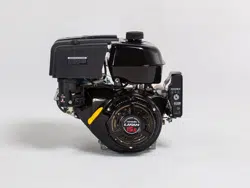Documents: Go to download!
- Owner's manual - (English)
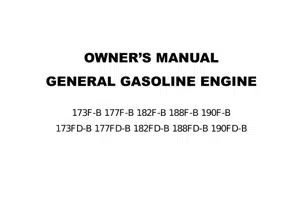
- PARTS DESCRIPTION
- PRE-OPERATE INSPECTION
- STARTING OF THE ENGINE
- OPERATION
- STOP
- EXHAUST CONTROL SYSTEM
- MAINTENANCE
- TRANSPORT, STORAGE AND REMOVAL FROM STORAGE
- TROUBLESHOOTING
Table of contents
OWNER’S MANUAL GENERAL GASOLINE ENGINE
PARTS DESCRIPTION
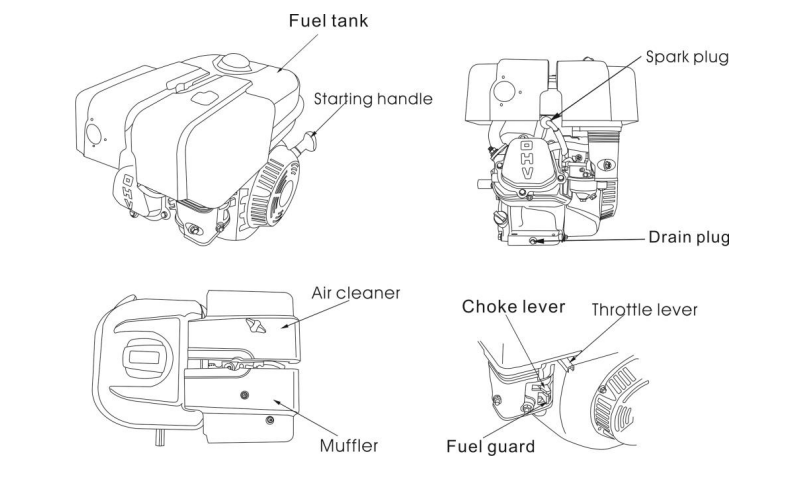
PRE-OPERATE INSPECTION
ENGINE OIL
CAUTION
- Engine oil is a key factor in deciding the engine’s performance. Do not apply engine oil with additives or 2-stroke gasoline oil, as they haven’t enough lubrication, which may shorten the engine’s service life.
- Check the engine with it stopped on a level ground.

Engine oil recommended: SAE10W-30。 As viscosity varies with regions and temperatures, so the Lubricant has to be selected in accordance with our recommendation. (Pic.1)
Inspect step:
- Remove the dipstick and clean it. (Pic. 2)
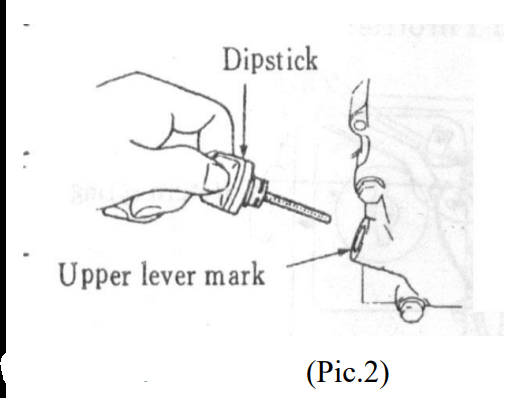
- Reinsert the dipstick into the oil filler without Screwing in, and check oil level.
- If the oil level is too low, add recommended engine oil to the filler neck
- Reinstall the dipstick.
CAUTION Run with insufficient engine oil may damage the engine severely.
OIL IN THE REDUCTION GEAR BOX (only for the model equipped with it)
½ Reduction gearbox with an auto-centrifugal clutch.
- Remove the dipstick and clean it. (Pic. 3. Pic.4)
- Reinsert the dipstick without screwing it in, and then take out it and check oil level.
- If the oil level is too low, and recommended engine oil until it arrives the upper level mark.
Brand of the oil is the same as that of engine oil.
Oil capacity: 0.50 liters

AIR CLENANER(Pic. 5)
CAUTION Never run the engine without an air cleaner, or severe wear of the engine may occur.
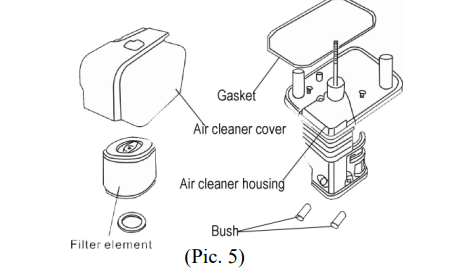
Dismantle the air cleaner housing and check its filter element, make sure it is clean and intact, otherwise clean or replace it.
FUEL
- Gasoline is extremely flammable and may explosive under certain conditions.
- Refueling in a well – ventilation area with the engine stopped. Do mot smoke and allow flames or sparks In the area where gasoline is stored or where the fuel tank is refueled.
- Do not overfill the tank (there should be no fuel in the filler neck). After refueling, make sure the fuel tank cap is set back securely.
- Be careful not to spill fuel when refueling. Spilled fuel or fuel vapor may ignite. If any fuel is spilled, make sure the area is dry enough before starting the engine.
- Avoid repeated or prolonged contact with skin or breathing of fuel vapor. Keep out of reach of children.
Fuel tank capacity: (173F-B/177F-B:5.5 liters); (182F-B/188F-B/190F-B: 6.0liters)
The engine must apply unleaded gasoline with an octane number over 86.Using unleaded gasoline will decrease the possibility of producing carbon deposit and prolong the engine’s service life.
Never apply used or polluted gasoline or a mixture of gasoline and engine oil. Make sure the fuel is free of dirt and water.
CAUTION
- Handle fuel with care because it can damage plastic and painted surfaces. It is not in our guarantee range of damage by fuel spilling.
- It is normal when you hear occasionally light spark knock or pinking with the engine running under heavy load.
- Should spark knock or pinking be heard at a speed under normal load, change brand of gasoline; If such phenomenon still happens, consult your dealer for help, otherwise, the engine may be damaged.
CAUTION The engine would be damage when it is running with constantly knock or pinking noise. It is not in our warranty range that its damage by misusage the engine
STARTING OF THE ENGINE
- Push the fuel switch to “ON”. (Pic.6)
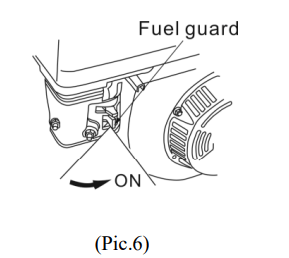
NOTE:If the engine is hot, closing the choke is unnecessary. - Push the chock lever to “OFF”. (Pic.7)
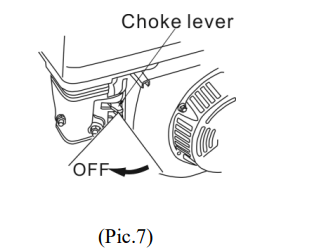
- Move left the throttle lever a little. (Pic.8)
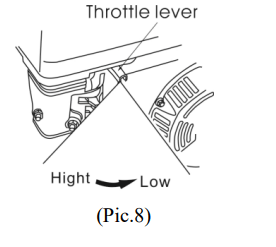
- Start the engine
- Rope handle Starter.
Push the engine switch to “ON”. (Pic. 9)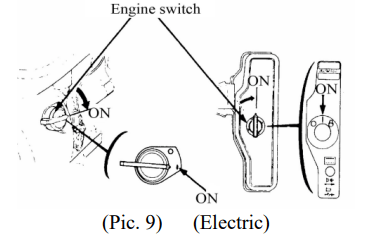
Pull slightly the starting rope handle up until feeling anti-action, and then make a rapid pull. (Pic. 10)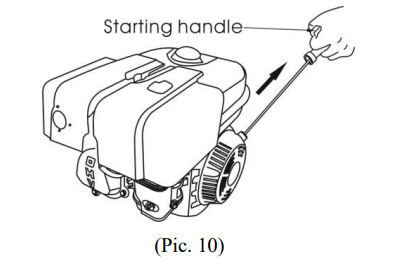
- Rope handle Starter.
CAUTION
Releasing the handle suddenly may make it hitting the engine. Release the handle slowly conforming to its recoiling force.
Electric starter
Push the engine switch to “START” and remain there until the engine Start. (Pic. 11)
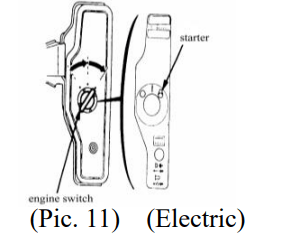
CAUTION Use the engine switch not more than 5 second each time to avoid damage of the engine. Try once more 10 second later after last attempt failures.
Once the engine starts, reset the engine switch to “ON”.
OPERATION
- Preheat the engine and push back the choke lever to “ON”.(Pic.12)
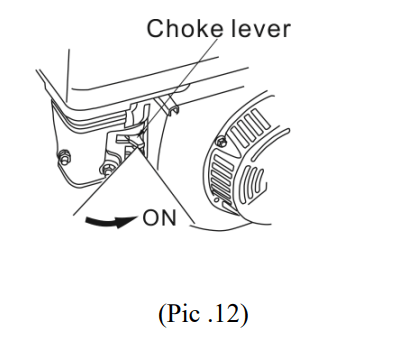
- Set the throttle lever in proper position to ensure the engine runs at required velocity.(Pic.13)
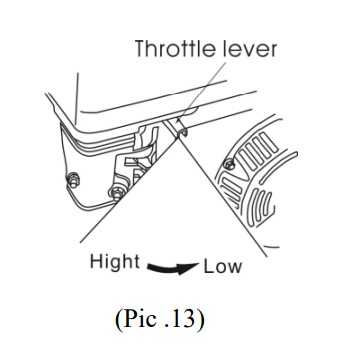
 Engine Oil Alarm
Engine Oil Alarm
The engine oil alarm is designed to alarm the user the fact that the engine oil in the crankcase in insufficient.
Run with insufficient engine oil may damage the engine. Once oil level in the crankcase is too low, the engine oil alarm will stall the engine automatically to make it free of damage while the engine switch is still at “ON”.
CAUTION If the engine still fails to work, check the engine oil level first before go to other check items.
Breaker(Electric start)
Breaker is used to protect the battery charging circuit. It will be disconnection when short circuit or battery polarity connects in wrong direction. (Pic .14)
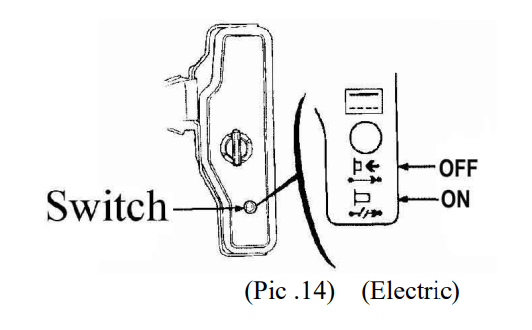
The green indicator would be light once the circuit off. If this happen, please find out the reason and solve it then press the button to recover the breaker.
 Operating on Highlands
Operating on Highlands
On highlands, the standard mixture ratio is relatively too big so the engine performance may be impaired while the fuel consumption may increase. This problem can be solved as follows: replace the main jet of carburetor with a smaller one, then, adjust the idly screw. If always using on highlands with a height above sea level of 1830 meters, ask your dealer for doing the job.
The engine power will decrease by about 3.5% with every 305 meters up in height; even the proper main jet is used.
The output would be much lower if not adjust the jet.
CAUTION The engine equipped with the main jet applicable to highlands may be damaged seriously in area below specified altitude, because its mixture ratio is too thin, output drops and the engine overheats for operation in low altitude area. In the case, ask your dealer to recover the engine to its normal technical status.
STOP
In an emergency, push the engine switch to “OFF” to stall the engine. Stop it in normal in the following sequence:
- Push right the throttle valve lever to the bottom (Pic. 15).
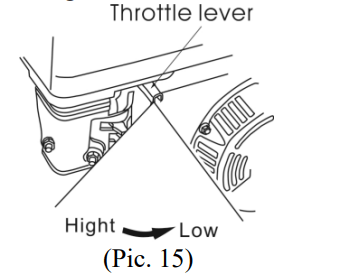
- Push the engine switch to “OFF” (Pic. 16)

- Set the fuel switch to “OFF” (Pic. 17)
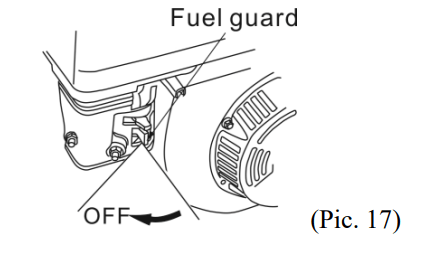
EXHAUST CONTROL SYSTEM
With the engine running, carbon monoxide, oxide of nitrogen and hydrocarbon will produce, and in certain conditions, oxide of nitrogen and hydrocarbon will react chemically each other to make smoke while carbon monoxide is toxic, so exhaust control of them is very important. The company decreases the exhaust emissions by introducing poor-fuel carburetors and other devices into the engine to solve the problem.
To keep the exhaust of your engine within the standard exhaust emission values, pay attention to the following:
I. MAINTENANCE
Maintain the engine periodically in accordance with the Maintenance Schedule in the manual. The maintenance schedule is made out on the base of normal use in normal conditions, if using under heavy load, dusty or wet circumstances or in high temperature, more frequents maintenance will be necessary.
II. REPLACEMENT OF PARTS
We recommend that you should choose such parts, which are manufactured by our Co. or equivalent to these in quality as replacement ones. Replacement without so high quality may impair the exhaust control system in effectiveness.
III. MODIFYING
Modifying the exhaust control system may make actual exhaust emissions exceeding statutory limit values. Illegal modification is as follows:
Dismantle or modify any part of air inlet or outlet system.
Modify or take off speed-adjusting connection device or speed adjustment device to result in the engine’s running or outside the set parameters.
IV. PROBLEMS AFFECTING EXHAUST EMISSIOS
- Difficult starting or difficult stopping.
- Unstable idling.
- Give off black smoke or consume too much fuel.
- Poor ignition sparks or sparks returned.
- Ignition is too advanced.
Once you find any of above problems, contact your dealer for help.
MAINTENANCE
MAINTENANCE SCHEDULE
To keep the engine in a sound condition, the user should maintain it according to the table below:
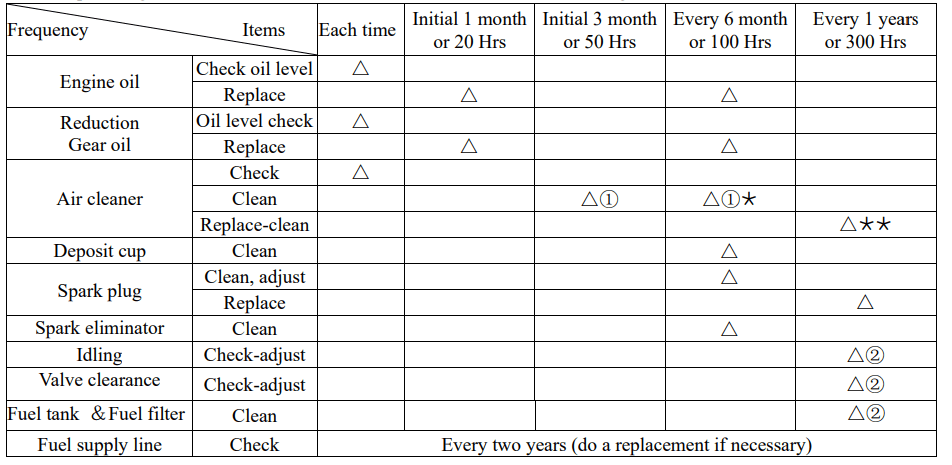
NOTES
- More often than that in the schedule if in dusty circumstances.
- The items should be done by your dealer you are specially trained and is well equipped with tools.
 Only for inside-ventilating double-core carburetors.
Only for inside-ventilating double-core carburetors.

 Only for paper core air cleaners.
Only for paper core air cleaners.
METHOD
- Replacement of Engine Oil
A still hot engine is helpful to drain out the engine oil in the crankcase rapidly and entirely. (Pic. 18)
- Turn off the oil filler cap and drain plug to drain engine oil thoroughly. Reinstall the drain plug and screw in securely.
- Fill the specified engine oil to the upper lever mark..
- Reinstall the oil filler cap.
Engine oil capacity of the crankcase is 0.6 liters.
Engine oil capacity of the 1/2 reduction gearbox is 0.5 liters.
Engine oil capacity of the 1/6 reduction gearbox is 0.15 liters.
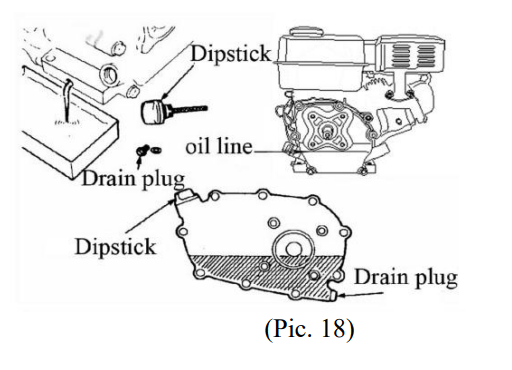
NOTE
Do not dump oil containers or discarded engine oil into rubbish boxes or onto the ground. For the sake of environmental protection, we suggest you take in discarded engine oil with a closed container and bring to local recycling station.
2. Service of Air Cleaner
A dirty air cleaner may block enough air’s flowing into the carburetor. To keep the carburetor in
Good working conditions, please service the air cleaner periodically. If operating the engine in extremely dusty area, the job should the done more often.
WARNING Never clean the air cleaner core in gasoline or low flash-point detergents, or explosion may happen.
CAUTION
Never run the engine without an air cleaner, or air with dirt and dust may enter the engine so speed the engine’s wear.
- Turn off the air cleaner’s cap, and then separate the filter to check the air clearer filter weather worn out or broken. If there is something wrong with it, please replace it.
- Clean with home detergents and warm water (or non-flammable of high flash-point cleaning solvents) and dry up.
- Sock in clean engine oil until saturated. Squeeze out excess oil, otherwise, the engine will discharge smoke in starting stage.
- Empty the oil in the air cleaner, Use non-flammable or high flash-point cleaning solvents to clean the dusty, and then dry-up the air cleaner box.
- install the air cleaner filter and cover to original position.
WARNING
- Gasoline is extremely flammable and explosive in certain conditions. Keep cigarette, sparks and open flames away.
- After reinstalling the deposit cup, check it for leakage and make sure the area around the engine is dry enough.
Spark Plug
Spark plug type: F6TC or BPR6ES (NGK)
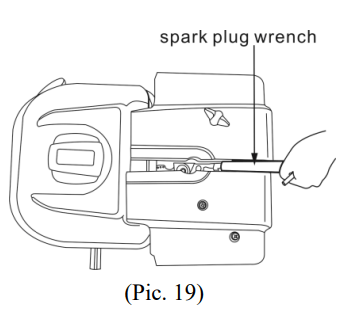
Proper spark plug clearance and without deposit around the spark plug ensure the engine’s normal running.
- Remove the spark plug by means of spark plug wrench. (Pic. 19)
WARNING Be careful not to touch the muffler during or just after running the engine. - Clean the spark plug with a steel brush. If the insulator is damaged, replace the spark plug instead.
- Measure the spark plug clearance with a feeler. The clearance should be 0.7~0.8mm,If adjustment is necessary, bend the side electrode carefully. (Pic. 20)
- Check if the spark plug gasket is in good conditions, or replace with a new one.
- Screw on the spark plug to the bottom first by hand and then tighten it up by a spark plug wrench.(Pic. 21)
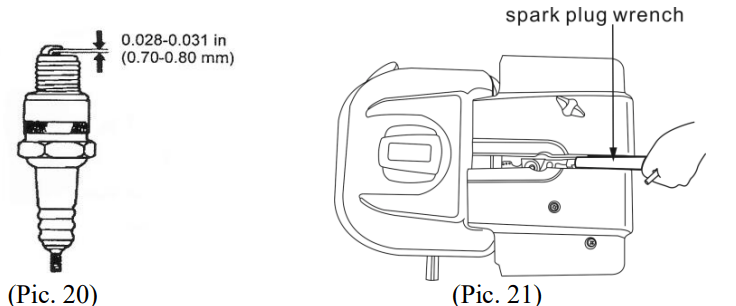
If a new spark plug is used, twist 1/2 more turns after impacting the gasket; if reinstall the original one, just twist 1/8~1/4 more turns.
CAUTION
- The spark plug must be tightened securely, or it may become very hot to damage the engine.
- Only use recommended spark plug or the equivalent. Incorrect heat range of the spark plug may damage the engine.
Spark Eliminator (Option) (Pic. 22)
The spark eliminator should be serviced at least once every 100 hour’s operation so as to keep it in a sound condition.
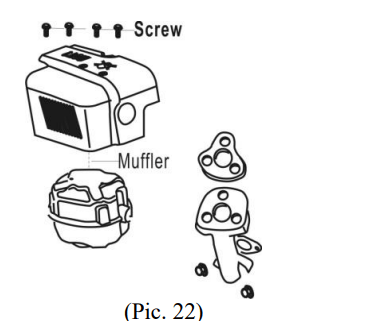
WARNING
The muffler is very hot during running the engine and even a long
Time after stopping. Never touch it, or you may get burns. Service
After the engine cools down.
- Unscrew two nuts M4, and remove the exhaust elbow from the engine body.
- Turn off five screws M5 from the muffler guard and take out the latter.
- Turn off screw M4 from the spark eliminator and separate it from the muffler.
- Clear away carbon deposit from the spark eliminator mesh with a brush.
- Reinstall the spark eliminator in reverse order of removal. (Pic. 23)
CAUTION
- Be careful not to damage the mesh of the spark eliminator.
- Never use a damaged spark eliminator.
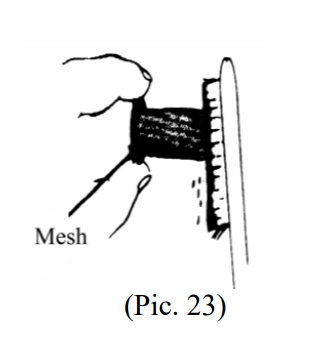
Adjustment of Carburetor Idling (Pic. 23)
- Start and preheat the engine until arriving at its normal working temperature.
- Obtain standard idling by adjusting the throttle fixing screw under the engine runs at a low speed. (Pic. 24)
Standard idling: 1500±150rpm
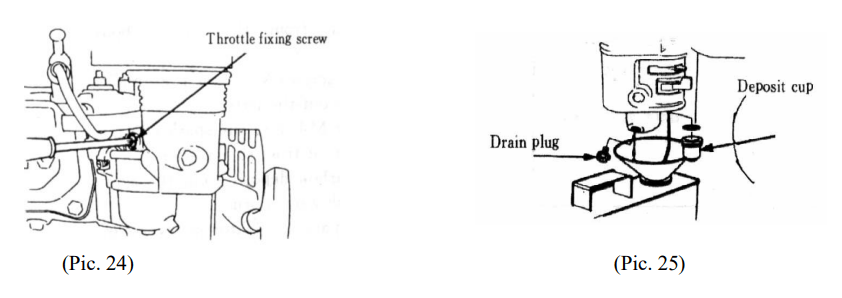
TRANSPORT, STORAGE AND REMOVAL FROM STORAGE
I.TRANSPORT
Transport with the fuel switch turned off. Transport or store the engine it is cool so as to avoid getting burns or fire.
If the engine is not kept in use for a long time, be sure to store it properly.
- Make sure the storage area is dry and free of dust.
- Make sure to put the oil (which in the gasoline tank and carburetor) into another proper container.
CURTION
Fuel is extremely flammable and explosive under certain conditions. Keep cigarette, open flames and sparks away from operating site.
- Replace the engine oil.
- Disconnect the spark plug. Fill a spoon of fresh engine oil from the spark plug mount hole into the cylinder. Rotate the engine to distribute engine oil evenly, followed by fitting the spark plug to original position.
- Pull the starting rope slowly until feel a slight anti-action, and then keep pulling so as to align the arrow of the starting sleeve with the hole of the starter. At this time, both the inlet and outlet valves are closed so to help prevent the engine inside from rusting.
- Electric starter: disconnect the battery and store in dry and cool area. Charge once every month.
- Cover the engine so keep dust away
TROUBLESHOOTING
STARTING ENGINE DIFFICULTLY
TROUBLE | CAUSE | REMEDY |
| There is no enough fuel in fuel tank or fuel cock is closed | Fill fuel, open fuel cock |
| Air vent in the filler cap is clogged. | Dredge air vent | |
| Fuel cock is clogged. | Clean first and then dredge | |
| Improper or clogged main jet | Readjust or clean, blow to get through | |
| Needle valve is closed improperly or start hole is clogged | Dismantle needle valve and repair, clean, blow to get through | |
Floater is damaged or sticking
| Repair floater | |
| Fuel is filthy or deteriorated | Replace |
| There is filthy or deteriorated | Replace | |
| Too much fuel in engine cylinder | Drain extra fuel, dry up spark plug electrodes | |
| Wrong fuel brand | Select proper fuel brand corresponding with Requirements | |
| Too much carbon fouling and dirt around electrodes | Clear away |
| Electrodes are burn damaged seriously or insulators damaged | Replace spark plug | |
| Improper electrodes gap | Adjust to proper value | |
| High-pressure coil is damaged
| Replace |
Ignition coil damaged Replace
| Replace |
WARNING
- When testing the spark plug, never hold the high- voltage wire of the spark plug with wet hand.
- Make sure there is no spilled fuel outside the engine and that the spark plug isn’t dipped with fuel.
- To prevent fire, keep sparks for away from the spark plug mount hole.
Once you find any of above problems, contact the authorization entitle to the dealer of the privilege helps for you.
TROUBLE | CAUSE | REMEDY |
| Piston ring is so worn to over its wear limit | Replace a set of piston rings |
| Piston ring is sticking | Clear up carbon fouling | |
| Piston ring is broken | Replace | |
| Spark plug is not installed tighten or without a gasket | Tighten with a gasket in | |
| Air leakage between cylinder block and cylinder | Check cylinder gasket and the flatness of the surface by which cylinder black on-tacting with cylinder head; tighten cylinder bolts in the order to stipulated torque | |
| Air leakage in valve | Check valve clearance and tightness, repair if necessary |
LOW GASOLINE ENGINE POWER OUTPUT
TROUBLE
TROUBLE
TROUBLE
TROUBLE | ||
TROUBLE | CAUSE | REMEDY |
There is noise of beating or piston slap is heard | Piston or piston ring or cylinder is worn | Replace the worn |
| Tie rod or piston pin and piston pin hole is worn | Replace the worn | |
| Main bearing of crankshaft is worn | Replace | |
| Piston ring is broken | Replace | |
There is metal-beaten noise in abnormal combustion | Too much carbon deposit in combusting chamber | Clear away carbon deposit |
| Too small electrodes clearance of spark plus | Adjust electrodes clearance properly | |
| Engine is flooded with fuel | Check relative parts such as carburetor | |
| Improper fuel brand | Replace fuel | |
| Engine is excessively hot | Shoot trouble | |
The other | Improper valve clearance | Readjust valve clearance properly |
| Fly wheel is not connected to crankshaft Tightly | Connect tightly |
Download User Manual
Lifan LF190F-BDQ-C Questions and Answers

Lifan
Owner manual PDF of Lifan LF190F-BDQ-C 15 MHP 420cc General Gasoline Engine.
Use manuals file type: PDF. Lifan - Charger & Adapter
